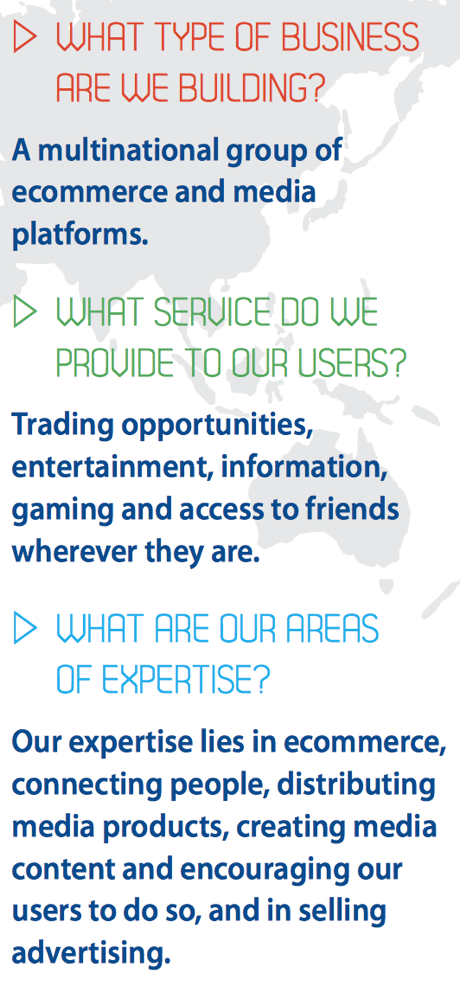"The stake in Tencent is worth more than the Naspers market cap. Again this reiterates that the South African investment community think that the Chinese in Hong Kong overpay for Tencent, clearly there is more than a whiff of arrogance in that."
To market, to market to buy a fat pig. Stocks closed higher on the day here locally, industrials were the real stars on the day. The reason was half attributed to Naspers, the stock moved higher as news came through that Chinese regulators have allowed Tencent to open a private bank, Webank is the name, Tencent will own 30 percent, the rest by private businesses and individuals.
Remembering that this is relevant to Naspers because they own 33.85 percent of Tencent, it is the biggest driver of their share price. 33.85 percent of Tencet's market cap of 1,204 trillion Hong Kong Dollars as per the Stock Information of the Tencent website (at 1.36 Rand to the Hong Kong Dollar) is 554 billion Rand. Market cap of Naspers? 545 billion Rand last evening. What? It does not make any sense to me, admittedly Naspers had not opened here, but you get a satellite TV business for free essentially.
A little more about Webank quickly, the other main founders are a crowd called Shenzhen Baiyeyuan Investment Company and Shenzhen Liye Group. The bank will be serving individual customers as well as small and micro-businesses. It will be located in Shenzhen. This is a push in the direction of the Chinese authorities to privatise the banking sector in the country, allowing for a more competitive landscape.
Alibaba and Tencent were able to capture around 65 billion Dollars of client funds into money markets at higher rates before the authorities even put those plans out to pasture, this is a sign that the authorities recognise that privatisation of the banking sector is needed. How does this make you feel as a shareholder indirectly of Chinese loans and banking assets? Much more on Naspers in just a moment.
A late surge in the markets on Wall Street after a poor start saw the S&P 500 and the Dow Jones gain back some of the losses Friday. Remember that this week is the non-farm payrolls week, which means major excitement into the weekend. On Wednesday there is the precursor to that with the ADP data, that is the private payroll estimate. US GDP data, the second look for the second quarter is due tomorrow too. On the local front we have unemployment data today, expectations for the unemployment rate are a shoulder-shrugging-we-must-try-harder 25.4 percent. Yowsers.
We saw Naspers release their annual report late last week, it is always a fabulous time to re-look at the company as an investment and see whether the reason you still hold them rings true. On an out and out earnings basis, the company is expensive, that much is true, on an NAV basis you are getting all the rest of the business for free. So it seems that the local market discounts the heavy weighting to Tencent and in doing that suggests that Tencent should be worth less.
Firstly, what do Naspers do now and what do they want to do in the future? A graphic capture from the annual report says it all:

Sounds rather ambitious and difficult to pin down at the same time, equally it is simplistic. The way I view it is simple, Naspers aim to be the champion of media platforms and ecommerce platforms mostly outside of the English speaking world. Their global platform spans all the continents, including the US and Canada, the focus will no doubt be in emerging markets.
The introduction spells that out:
"Naspers is a broad-based multinational media group with principal operations in internet services and ecommerce (especially online classifieds, etail and payments), pay television and print media. We operate predominantly in markets with growth potential. These include Africa, China, Latin America, Central and Eastern Europe, Russia, India, Southeast Asia and the Middle East. Most of our businesses are market leaders in their sectors."
The classifieds business are the likes of OLX, entail, think Kalahari.com, marketplace (swap), think Allergro, pricecheck.com is a comparison platform, Pay U is exactly that, a payments platform whilst the company has stakes in global growth businesses in India (Ibibo and Redbus.in). In amongst many other businesses that are key leaders in their geographies, that includes Souq.com and Flipkart, you might have heard of those businesses. So that is the ecommerce push, the next big growth area that Koos Bekker often refers to.
Next are the two businesses that you know possibly the best in the Naspers stable, the aforementioned Tencent (which trades on a very lofty 54 earnings multiple) and Mail.ru. Mail.ru is listed in the over the counter market in London and trades in Dollars, the current share price is close to 27.95 Dollars, the market cap is 3.32 billion Dollars at that level.
Naspers (through MIH) owns 29 percent of Mail.ru (see -> Mail.ru Shareholder Capital structure) which translates to 962 million Dollars, or at 10.6 to the Rand, 10.2 billion Rand. Interestingly Tencent owns 7 percent of this business, Mail.ru too. As a percentage of the Naspers market cap (545 billion Rand), Mail.ru represents only 1.8 percent. It was more, the share price of Mail.ru understandably has been under significant pressure.
As we pointed out above, the stake in Tencent is worth more than the Naspers market cap. Again this reiterates that the South African investment community think that the Chinese in Hong Kong overpay for Tencent, clearly there is more than a whiff of arrogance in that.
Just for comparison sake, Times Media (which after loads of selling of non core assets) owns Sunday Times, the Sowetan and the Business Day is valued by the market at 2.7 billion Rand or 0.5 percent of the value of Naspers. There was a time when these companies were considered peers, that time is best left to when Aurora touched the spinning wheel and fell into a deep sleep, through no fault of anyone, rather the sheer brilliance of Koos Bekker and some brilliantly timed acquisitions.
Interestingly the print assets, which consist of Media24, Paarl media, Abril (Brazil) and Jonathan Ball publishers still managed to generate EBIDTA of 1.073 billion Rand on 11.692 billion Rand worth of turnover. Pay TV, my favourite and most used Naspers product had revenues of 36.271 billion Rand and EBIDTA of 10.370 billion Rand. What would you pay for those businesses separately?
We suggested in the review of the results, titled Priming ecommerce that the TV assets could be worth between 80 to 100 billion Rand. On the same rating as Times Media group (EBIT of 13.5 times), the print assets are worth 14 billion Rand. Add the TV and the print together and you get a business that is roughly 100 billion Rand. You get that for free.
So what is the conclusion, we could talk about this business all day long. At the one end of the market you have the chattering classes suggesting that Tencent is woefully overvalued. To a large extent the prospects of Naspers in the medium term depend on the success of Tencent. I have seen an analyst report on Tencent that suggests a PE unwind to 2016 of 21 times at the current price, suggesting earnings grow rates of 40 percent plus this year, 30 percent plus next year and nearly 30 percent the year thereafter.
I would say for that reason alone one should continue to accumulate Naspers, Tencent will seem cheap at these levels in the coming years. If we (the collective we being South African) are so "clever" to discount them at current prices, then we should be so lucky that the real discount is inside Naspers. Great to re-look and confirm again.
Byron's beats
On the 24th of July Cerner reported second quarter results for 2014. Just as a refresher here is what this exciting healthcare business actually does according to the presentation.
"Cerner's health information technologies connect people, information, and systems, at approximately 14,000 facilities worldwide. Recognized for innovation, Cerner solutions assist clinicians in making care decisions and enable organizations to manage the health of populations. The company provides clients with a wide range of in-house services, as well as an integrated clinical and financial system to help organizations manage revenue. Cerner's mission is to contribute to the systemic improvement of health care delivery and the health of communities."
If you take a look at the image below which I screen grabbed from their website you will get a better idea of the services they offer. This includes linking pharmacies with hospitals and doctors, allowing data from medical devices to be recorded and stored by practitioners and member engagement which sounds very similar to what Discovery's Vitality do. I urge you to explore their website for a better feel of the company.
Lets take a look at the numbers.

Revenues increased 20% to $851mn while earnings per share grew 18% to 40 cents. Earnings for the full year are expected to come in at $1.66. That is expected to grow to $2 in 2015 and $2.36 in 2016. The stock currently trades at $57 or 34 times this years earnings. But with earnings expected to grow 20% next year and 18% the following year you can understand why. Another phenomenal figure which Cerner boast is a gross profit margin of 80.9%. Software businesses have low capital costs. This figure was actually down 1.3% on the previous quarter because some third party outsourcing had to be done to fulfil ever growing orders.
Having absorbed all of the above it is quite clear why this company falls within the Vestact recommended list. They are creating technologies which make healthcare more efficient. And lets be honest, everyone wants healthcare to be more efficient from government, to the poor, to the rich. The more affordable and accessible healthcare is the better a place the world becomes.
Cerner are still very much a US company and growing their footprint around the globe has huge potential. Their CEO, Chairman and Co-Founder Neal Patterson is held under very high regard. The company already has a market cap of $20bn and is one of the leaders in the industry. We continue to add to Cerner as one of our leading exposures to the healthcare industry.
Home again, home again, jiggety-jog. Markets are trading near a record high locally if I am not mistaken, the Russians are on the back foot I guess. I suspect that sort of behaviour might be welcomed back home, the rest of the world however frowns upon that.
Sasha Naryshkine, Byron Lotter and Michael Treherne
Follow Sasha, Byron and Michael on Twitter
011 022 5440
No comments:
Post a Comment